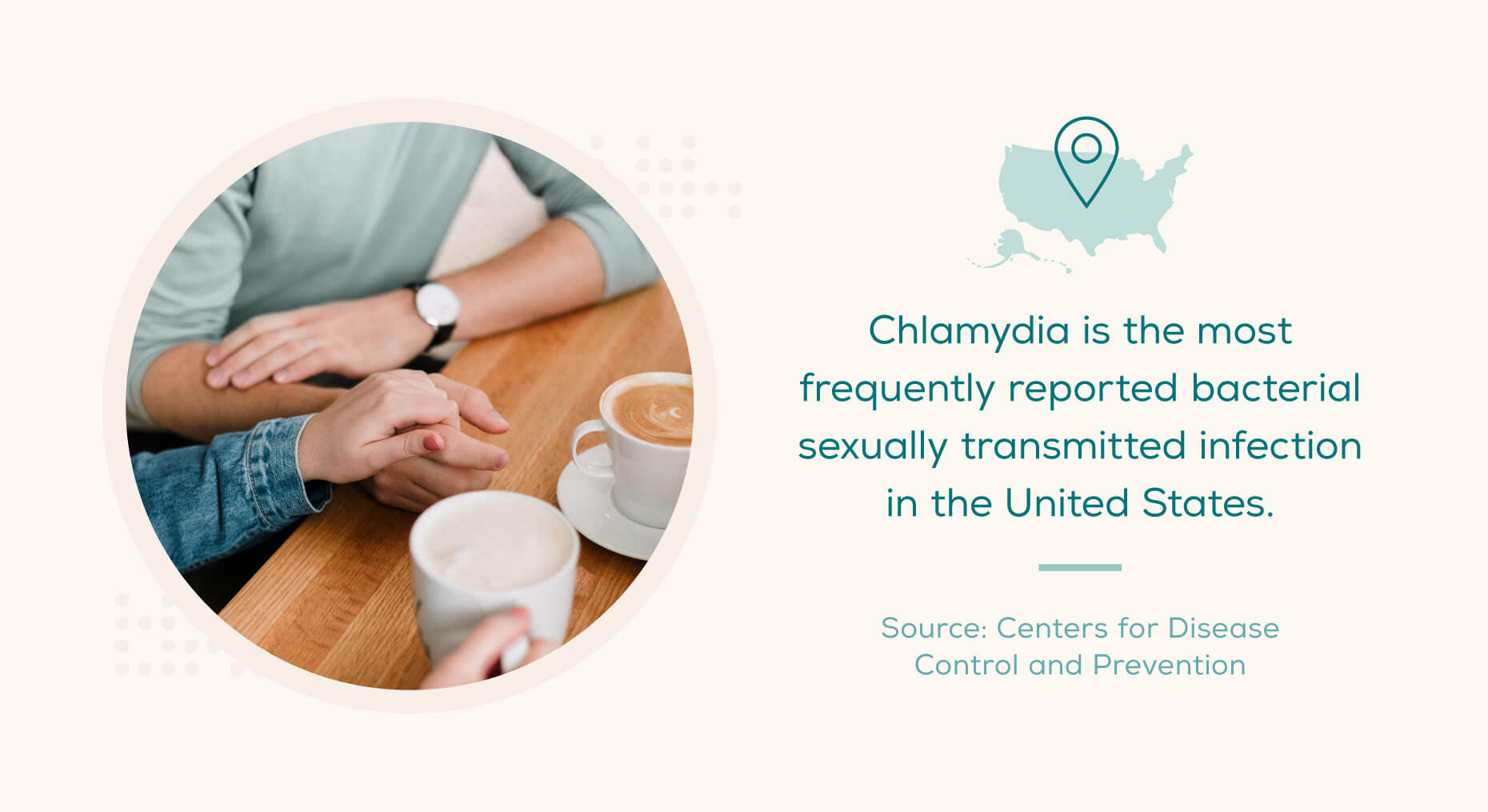
Can You Get Chlamydia From Kissing?
Medically reviewed on May 23, 2022 by Jordan Stachel, M.S., RDN, CPT. To give you technically accurate, evidence-based information, content published on the Everlywell blog is reviewed by credentialed professionals with expertise in medical and bioscience fields.
Table of contents
- Kissing and Chlamydia: Are There Any Risks?
- So, How Does Chlamydia Spread?
- Common Symptoms To Look Out For
- How To Prevent Chlamydia
Despite what you might have heard, you cannot get chlamydia from kissing. Chlamydia is a sexually transmitted bacterial infection that is only transmitted through anal, vaginal, and/or oral sex. It is a relatively common STI that affects around 4 million Americans every year, mostly those under the age of 25, and there is a lot of misinformation circulated about this infection.
In this article, we’ll clear the air and explain exactly how chlamydia spreads, what symptoms might look like (though oftentimes those who have it are asymptomatic), and exactly what you can and cannot contract from locking lips.
Kissing and Chlamydia: Are There Any Risks?
Because chlamydia cannot be transferred via saliva, you are not at risk of contracting the infection from kissing. Nonsexual contact is safe because, again, it is only spread through anal, vaginal, and/or oral sex.
However, it is worth pointing out that ejaculation does not have to occur to spread chlamydia, so anytime you are having sex without protection, you’re putting yourself at risk for any sort of sexually transmitted infection.
Can You Get Chlamydia From Sharing Drinks?
You cannot get chlamydia from sharing drinks. As mentioned above, chlamydia cannot be transferred via saliva, so there is no risk involved in sharing food or drinks, or even engaging in other forms of casual contact like holding hands, coughing, sneezing, hugging, or sitting on the toilet.
So, How Does Chlamydia Spread?

Chlamydia spreads through anal, vaginal, and/or oral sex. It’s carried in semen and vaginal fluids and can infect areas such as the vagina, penis, cervix, anus, and urethra, as well as the eyes and throat.
Here are some other important facts to know about the spread of chlamydia:
- Even if no one ejaculates, you can still contract chlamydia during sex.
- You can spread chlamydia to other parts of the body without sexual contact. For example, if you have a vaginal chlamydia infection and you use the bathroom, you can spread it to your anus simply by wiping.
- Even if you’ve had and been treated for chlamydia before, you can be reinfected with the disease if exposed a second time or more.
- If you share sex toys and the toys have been exposed to chlamydia, it’s possible to spread the infection through them.
- Women with chlamydia can give the infection to a baby passing through the cervix during birth, which can lead to blindness, pneumonia, or other serious complications. The CDC recommends that women under 25 years old or at risk of infection test during the third trimester, and be retested within three months after birth if infected.
- Though rare, you can also transmit chlamydia to the eye if you have fluids on your hand and touch your eye.
Symptoms To Look Out For
Many people don’t show symptoms of chlamydia. In fact, nearly 70% of women are asymptomatic and about 50% of men with chlamydia, which is one of the reasons it can spread quickly and unknowingly. It’s important to test regularly if you’re sexually active because chlamydia can be dangerous if left untreated.
Symptoms include:
- Burning while peeing
- Abnormal discharge
- Unusual odor from the vagina or penis
- Heightened soreness around the genitals
- Rectal pain or anal bleeding if passed through anal sex
- Pain or swelling in one or both testicles for men
- Bleeding between menstrual periods for women
If left untreated, chlamydia can have serious long-term consequences. For men specifically, possible issues could include:
- Nongonococcal urethritis (NGU), or an infection of the urethra, which can lead to uncomfortable or frequent urination, abnormal discharge, and more
- Epididymitis, or an infection of the tube carrying sperm from the testes, which can lead to testicular pain and swelling
- Proctitis, or inflammation of the rectum
If left untreated in women specifically, issues could include:
- Pelvic inflammatory disease (PID), which can cause chronic pelvic pain and infertility
- Ectopic pregnancy, when an unfertilized egg grows outside the uterus and can damage organs or cause blood loss
- Preterm birth or other issues for babies that are delivered vaginally
How To Prevent Chlamydia

Using condoms or dental dams can reduce the risk of contracting chlamydia. It’s also a good idea to test regularly. Open the dialogue with your partner to chat about the importance of regular testing and how it can reduce any potential long-term risks.
To easily test for chlamydia from the privacy of your home, take the Everlywell Chlamydia & Gonorrhea Test. You can also check for six common sexually transmitted infections (including chlamydia) with the Everlywell at-home STD Test for women or men.
Young adults, especially those in their college years, are particularly at risk for getting chlamydia. That’s why it’s especially important to educate yourself on the causes, risks, and ways to regularly test to ensure you’re not spreading it from partner to partner. If you have any questions or concerns about HPV or other STIs, schedule an appointment with your healthcare provider to discuss risk factors, treatments, and testing options.
Article Sources
- Chlamydia – CDC Fact Sheet (Detailed). Centers for Disease Control and Prevention. URL. Accessed April 27, 2022.
- Chlamydia. Planned Parenthood. URL. Accessed April 27, 2022.
- Screening Recommendations and Considerations Referenced in Treatment Guidelines and Original Sources. Centers for Disease Control and Prevention. URL. Accessed April 27, 2022.
- Chlamydia – CDC Fact Sheet. Centers for Disease Control and Prevention. URL. Accessed April 27, 2022.
- Chlamydia Treatment and Care. Centers for Disease Control and Prevention. URL. Accessed April 27, 2022.
- Chlamydia. National Library of Medicine. URL. Accessed June 19, 2022.
- Trends in STDs in the United States. Centers for Disease Control and Prevention. URL. Accessed June 10, 2022.